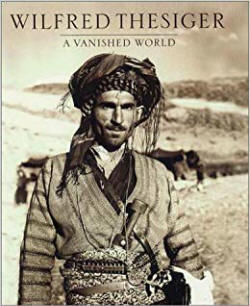

Queer Places:
Eton College, Windsor SL4 6DW, Regno Unito
University of Oxford, Oxford, Oxfordshire OX1 3PA
Milebrook House Hotel, Milebrook, Knighton LD7 1LT, Regno Unito
Putney Vale Cemetery, Stag Ln, Wimbledon, London SW15 3DZ, Regno Unito
 Sir Wilfred Patrick Thesiger KBE, DSO, FRAS, FRSL, FRGS (3 June 1910 – 24
August 2003),[1]
also called Mubarak bin London (Arabic for "the blessed one of London")[2][3]
was an English explorer and travel writer.
Sir Wilfred Patrick Thesiger KBE, DSO, FRAS, FRSL, FRGS (3 June 1910 – 24
August 2003),[1]
also called Mubarak bin London (Arabic for "the blessed one of London")[2][3]
was an English explorer and travel writer.
Thesiger's travel books include Arabian Sands (1959), on his foot and camel crossing of the Empty Quarter of the Arabian Peninsula, and The Marsh Arabs (1964), on his time living in the marshes of Iraq with the Marsh Arabs. He donated his collection of 38,000 travel photographs to the Pitt Rivers Museum, Oxford.
Thesiger was born in Addis Ababa, Ethiopia,[1] the son of Wilfred Gilbert Thesiger - British consul-general and minister to Addis Ababa from 1909 to 1919 - and his wife Kathleen Mary Vigors. Thesiger's grandfather was Frederic Lord Chelmsford. Frederic Viscount Chelmsford, future Viceroy of India, was an uncle, and the actor Ernest Thesiger was a cousin.
Thesiger was educated at St Aubyn's School in Rottingdean, Sussex, followed by Eton College and then Magdalen College, Oxford,[1] where he took a Third in History. Between 1930 and 1933, Thesiger represented Oxford at boxing and later (in 1933) became captain of the Oxford boxing team.[1] He was awarded a boxing Blue for each of the four years that he was at Oxford. Whilst at Oxford, Thesiger was also elected Treasurer of the Oxford University Exploration Club (1931–32).
In 1930 Thesiger returned to Africa, having received a personal invitation from Emperor Haile Selassie to attend his coronation. He returned again in 1933 as the leader of an expedition, funded in part by the Royal Geographical Society, to explore the course of the Awash River. During this expedition, he became one of the first Europeans to enter the Aussa Sultanate and visit Lake Abbe.
Between 1935 and 1940, Thesiger served with the Sudan Political Service stationed in Darfur and the Upper Nile.
At the outbreak of war, Thesiger joined the Sudan Defence Force, helping to organise the Abyssinian resistance to the occupying Italians. He was awarded the DSO[4] for capturing Agibar and its garrison of 2,500 Italian soldiers.
He later served with the Special Operations Executive in Syria and the Special Air Service during the North African Campaign, attaining the rank of Major. From 1943 to 1945 he acted as political adviser to Crown Prince Asfa Wossen of Ethiopia.
After the Second World War, Thesiger travelled across Arabia, lived for some years in the marshes of Iraq, and then travelled in Iran, Kurdistan, French West Africa and Pakistan. He lived for many years in northern Kenya.[5]
He is remembered for his Arabian expeditions. In 1945, an entomologist, O.B. Lean, acting on behalf of the Middle East Anti Locust Unit (MEALU), hired Thesiger to search for locust breeding grounds in southern Arabia. This led to two crossings of the great Arabian desert, the Rub' al Khali or Empty Quarter, and travels in inner Oman. He rode camels in the company of Bedu guides through remote areas that were potentially dangerous on account of tribal tensions and the opposition of local rulers to the presence of foreigners.[6]
Thesiger's first crossing began in October 1946 when, with his Bedouin companions, he left Salalah in the Dhofar province of Oman and travelled to the Mughshin Oasis. From there, he entered the sands but there was dissent among his party, some of whom were unwilling to travel any farther. Thesiger continued with four members, two from the Rashid and two from the Bait Kathir tribes. He reached the Liwa Oasis in the Emirate of Abu Dhabi in mid-December, visited the town of Abu Dhabi, then crossed into Oman, heading back towards Salalah via Dhofar and ending his journey at Salalah on 23 February 1947.[7]
His second crossing began in December 1947, at Manwakh well in Yemen. The king of Saudi Arabia did not agree to Thesiger entering his territory, and imprisoned Thesiger and his party when they arrived at Sulayil. Soon released, they travelled to the Liwa Oasis and then to Abu Dhabi town, arriving on 14 March 1948. In April, Thesiger visited the Buraimi Oasis, for which the Iraq Petroleum Company (IPC) held an oil concession, which it operated through an associate company, Petroleum Development Oman. Dick Bird, the company's representative, was concerned by Thesiger's attitude towards oil exploration. Thesiger disapproved of the company’s activities, believing that the discovery of oil would destroy the Bedouin way of life. However, the need to finance his expeditions led the explorer to accept funding from the oil company in exchange for providing information garnered from his travels.[6][7]
Thesiger returned to England in the 1990s and was knighted in 1995.[5]
He is known for two travel books: Arabian Sands (1959), which recounts his travels in the Empty Quarter of Arabia between 1945 and 1950 and describes the vanishing way of life of the Bedu; and The Marsh Arabs (1964), which is an account of the Madan, the indigenous people of the marshlands of southern Iraq. The latter journey is also covered by his travelling companion, Gavin Maxwell, in A Reed Shaken by the Wind – a Journey through the Unexplored Marshlands of Iraq (Longman, 1957; new edition by Eland in 2003).
Thesiger took many photographs during his travels and donated his vast collection of 38,000 negatives to the Pitt Rivers Museum, Oxford.[8]
My published books: